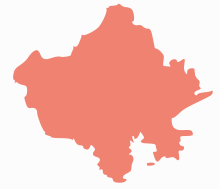Ajmer
Ajmer pronounced [ədʒmeːr] (![]()
Ajmer Ajayameru[1] | |
|---|---|
Metropolis | |
| Ajmer | |
.jpg) 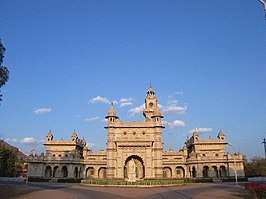 Prithviraj Chauhan statue in Ajmer, Mayo College | |
 Ajmer  Ajmer | |
| Coordinates: 26.4499°N 74.6399°E | |
| Country | India |
| State | Rajasthan |
| District | Ajmer |
| Founded by | Ajayaraja I or Ajayaraja II |
| Named for | Ajayaraja I or Ajayaraja II |
| Government | |
| • Body | Ajmer Development Authority (ADA), Ajmer Municipal corporation (AMC) |
| Elevation | 480 m (1,570 ft) |
| Population (2011)[2] | |
| • Metropolis | 542,321 |
| • Urban | 551,101 |
| Time zone | UTC+5:30 (IST) |
| PIN | 305001 to 305023 |
| Telephone code | 0145, +91145 |
| Vehicle registration | RJ-01(Ajmer)
RJ-36 (Beawar) RJ-42 (Kishangarh) RJ-48 (Kekri) |
| Website | www |
The city was established as "Ajayameru" (Translated as 'Invincible Hills') by a Shakambhari Chahamana (Chauhan) rajput ruler, either Ajayaraja I or Ajayaraja II, and served as the Chahamana capital until the 12th century CE.[3][4]
Ajmer is surrounded by the Aravalli Mountains. Ajmer had been a municipality since 1869.
Ajmer has been selected as one of the heritage cities for the HRIDAY - Heritage City Development and Augmentation Yojana[5] and Smart City Mission schemes of Government of India.[6]
History
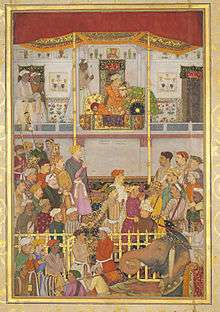
Ajmer was originally known as Ajayameru.[7] The 12th century text Prithviraja Vijaya states that the Shakambhari Chahamana (Chauhan) king Ajayaraja II (ruled c. 1110 – 1135 CE) established the city of Ajayameru.[4] Historian Dasharatha Sharma notes that the earliest mention of the city's name occurs in Palha's Pattavali, which was copied in 1113 CE (1170 VS) at Dhara. This suggests that Ajmer was founded sometime before 1113 CE.[8] A prashasti (eulogistic inscription), issued by Vigraharaja IV and found at Adhai Din Ka Jhonpra, states Ajayadeva (that is, Ajayaraja II) moved his residence to Ajmer.[3]
The later text Prabandha-Kosha states that it was the 8th-century king Ajayaraja I who commissioned the Ajayameru fort, which later came to be known as the Taragarh fort of Ajmer.[4] According to historian R. B. Singh, this claim appears to be true, as inscriptions dated to the 8th century CE have been found at Ajmer.[9] Singh theorizes that Ajayaraja II later expanded the town area, constructed palaces, and moved the Chahamana capital from Shakambhari to Ajmer.[10]
Mughal prince Dara Shikoh was born here in 1615. Jahanara Begum powerful Mughal princess also born here.
During Colonial times Ajmer city served as the headquarters of Ajmer - Merwara Province and possessed a Central jail, a large General Hospital, and two smaller hospitals according to Gazetteer, 1908. It was the headquarters of a native regiment and of a Railway Volunteer corps. From the 1900s, United Free Church of Scotland, the church of England, the Roman Catholics, and the American Episcopal Methodists have mission establishments here.[11] At that time there were twelve printing presses in the city, from which eight weekly newspapers were published.[12]
At the time of Independence Ajmer Continued as a separate state with its own legislature until its merger with erstwhile Rajputana province then called Rajasthan. The Legislature of Ajmer State was housed in the building which now houses T. T. College. It had 30 MLAs. and Haribhau Upadhaya was the first Chief Minister of the erstwhile state and Bhagirath Chaudhary as the first Vidhan Sabha Speaker. In 1956, after acceptance of the proposal by Fazil Ali, Ajmer was merged into Rajasthan to form Ajmer District with the addition of Kishangarh sub-division of Jaipur district.[13]
Other Name in Literature
Gujarati Historic Novel named Gujaratno Jay written by Zaverchand Meghani based on various Jain Prabandhas describes city as Sapadlakshan (સપાદલક્ષણ).[14]
Geography
Ajmer is in the northwest of India and is surrounded by the Aravali Mountains. It is situated on the lower slopes of the Taragarh Hill of that range. To the northwest is the Nagapathar Range of the Aravali Mountain Ranges which protects it from desertification from the Thar Desert.
Climate
Ajmer has a hot, semi-arid climate with over 55 centimetres (22 inches) of rain every year, but most of the rain occurs in the monsoon months, between June and September. Temperatures remain relatively high throughout the year, with the summer months of April to early July having an average daily temperature of about 30 °C (86 °F). During the monsoon there is frequent heavy rain and thunderstorms, but flooding is not a common occurrence. The winter months of November to February are mild and temperate with average temperatures ranging from 15–18 °C (59–64 °F) with little or no humidity. There are, however, occasional cold weather fronts that cause temperatures to fall to near freezing levels.
| Climate data for Ajmer | |||||||||||||
|---|---|---|---|---|---|---|---|---|---|---|---|---|---|
| Month | Jan | Feb | Mar | Apr | May | Jun | Jul | Aug | Sep | Oct | Nov | Dec | Year |
| Average high °C (°F) | 22.9 (73.2) |
25.7 (78.3) |
31.3 (88.3) |
36.5 (97.7) |
39.7 (103.5) |
38.4 (101.1) |
33.6 (92.5) |
31.3 (88.3) |
32.6 (90.7) |
33.5 (92.3) |
29.2 (84.6) |
24.7 (76.5) |
31.6 (88.9) |
| Average low °C (°F) | 7.6 (45.7) |
10.5 (50.9) |
16.0 (60.8) |
22.2 (72.0) |
26.8 (80.2) |
27.5 (81.5) |
25.6 (78.1) |
24.4 (75.9) |
23.7 (74.7) |
18.0 (64.4) |
12.3 (54.1) |
8.4 (47.1) |
18.6 (65.5) |
| Average rainfall mm (inches) | 7.3 (0.29) |
6.0 (0.24) |
5.0 (0.20) |
4.0 (0.16) |
15.7 (0.62) |
58.1 (2.29) |
181.5 (7.15) |
157.5 (6.20) |
73.0 (2.87) |
13.1 (0.52) |
4.0 (0.16) |
3.8 (0.15) |
529 (20.85) |
| Source: IMD[15] | |||||||||||||
Transportation
.jpg)
Road
The Kishangarh Airport is the nearest Airport. It was inaugurated by Former Prime Minister Manmohan Singh in September 2013.[16] The airport was inaugurated by Union Minister of State for Civil Aviation Jayant Sinha and Chief Minister Vasundhara Raje on 11 October 2017.[17]
Air
The Kishangarh Airport is the nearest Airport. It was inaugurated by Former Prime Minister Manmohan Singh in September 2013.[16] The airport was inaugurated by Union Minister of State for Civil Aviation Jayant Sinha and Chief Minister Vasundhara Raje on 11 October 2017.[17]
Rail
The Ajmer Junction is the main railway station situated in the city.[18] and was built during colonial times.
Landmarks and monuments
- Pushkar: Located few kilometers from Ajmer, is an important tourist and pilgrimage destination and a satellite town of Ajmer city. It is famous for Pushkar Lake and the 14th century Brahma Temple at Pushkar, dedicated to Brahmā, according to the Padma Purāņa, Pushkar is important pilgrimage site for Lord Brahmā.[19]. Around the world, Lord Brahma Temple is only situated at Pushkar Lake, Rajasthan, India.
- Manibandh or Chamunda Mata Mandir(Temple): is one among the 108 Shakti Peeth at Gayatri hills near Pushkar, 11 km from Ajmer. People know this temple as Chamunda Mata Temple. It takes 14 minutes to travel from Pushkar Lake to Chamunda Mata Mandir (about 5–6 km)
- Taragarh Fort: It is reputed to be the oldest hill fort in India. It stands, with precipitous surroundings, at a height of 2,855 ft. above sea-level, and between 1,300 and 1,400 ft. above the valley at its base; and it is partially enclosed by a wall some 20 feet thick and as many high, built of huge blocks of stone, cut and squared and are about two miles (3 km) in circumference. This hill fort guarding Ajmer, was the seat of the Chauhan rulers. It was built by King Ajaypal Chauhan on the summit of Taragarh Hill and overlooks Ajmer. The battlements run along the top of the hill. When it fell to the British Raj, the fort was dismantled on the orders of Lord William Bentinck in 1832 and was converted into a sanatorium for the British troops stationed at the garrison town of Nasirabad.[20] Within it stands the shrine of a Muhammadan saint, Saiyid Husain, known as the Ganj Shahldan.In the older city, lying in the valley beneath the Taragarh hill and now abandoned, the Nur-chashma, a garden-house used by the Mughals, still remains, as also a water-lift commenced by Maldeo Rathor, to raise water to the Taragarh citadel.
- Ajmer Sharif Dargah: It is a shrine of Khwaja Moinuddin Chishti which is situated at the foot of the Taragarh hill, and consists of several white marble buildings arranged around two courtyards, including a massive gate donated by the Nizam of Hyderabad, and the Akbari Mosque, built by the Mughal emperor Shah Jahan and containing the domed tomb of the saint. Akbar and his queen used to come here by foot every year on pilgrimage from Agra in observance of a vow when he prayed for a son. The large pillars called "Kose ('Mile') Minars" (Kos Minar), erected at intervals of about two miles (3 km) along the entire way between Agra and Ajmer mark the places where the royal pilgrims halted every day, they are also seen today, one such is near private bus stand in Ajmer City.[20] About 125,000 pilgrims visit the site every day. The Urs of Khwaja Moinuddin Chishti is celebrated every year on the 6th and 7th of Rajab.
- Tomb of Khwaja Husain Ajmeri: Khwaja Husain Ajmeri also known as Shaikh Husain Ajmeri, he was a Grandson of Khwaja Moinuddin Chishty of Ajmer from the line of Khwaja Fakhruddin's son Khwaja Husamuddin Jigar Sokhta, he was SajjadaNasheen & Mutwalli[21] of Ajmer Dargah before & the time of Emperor Akbar & Emperor Jahangir, his tomb situated near Sola Khamba (Tomb of Khwaja Alauddin another grandson of Khwaja Moinuddin Chishty of Ajmer), Behind Shahjahani Mosque Dargar Sharif Ajmer, he was leave the world in the year 1619-20 his tomb build in the year 1637–38.
- Soni Ji Ki Nasiyaan : It is architecturally rich Jain temple built in the late nineteenth century whose main chamber Swarna Nagari "City of Gold", has prominent depiction of Ayodhya made from 1000 kg of gold.[22]
- Mayo College: The college was founded in 1875 at the suggestion of Lord Mayo as a college where the sons of chiefs and nobles might receive an education to fit them for their high positions and important duties.[23] It was known as "Indian Eton", as a number of Indian princes studied in this college. The main building, in white marble, is a classic example of Indo-Saracenic architecture. In front of the college is memorial marble statue of Lord Mayo. The boarding-houses are arranged in the form of a horseshoe, with the college in the centre of the base. Some of the Native States built boarding-houses, while the Government of India presented the college park, comprising 167 acres and formerly the site of the old Residency, and erected the main building, the residences of the principal and vice-principal, and the Ajmer boarding- house. It provided the salaries of the English staff. The foundation-stone of the college was laid in 1878, and the building was opened by the Marquis of Dufferin in 1885.[23] John Lockwood Kipling, father of Nobel Laureate, Rudyard Kipling, had been principal of Mayo College.
- Akbari Fort & Museum: The city's museum was once the residence of Prince Salīm, the son of the Emperor Akbar, and presently houses a collection of Mughal and Rajput armour and sculpture. This is a magnificent example of Mughal architecture, construction of which was commissioned by Akbar in 1570. This is where Salim, as the Emperor Jahangir, read out the firman permitting the British East India Company to trade with India.[24] It is a massive square building, with lofty octagonal bastions at each corner. It was the headquarters of the administration in their time and in that of the Marathas. It was here that the emperors appeared in state, and that, as recorded by Sir Thomas Roe, criminals were publicly executed. The interior was used as a magazine during the British occupation until 1857; and the central building, used as a tahsil office. With the fort, the outer city walls, of the same period, are connected. These surround the city and are pierced by the Delhi, Madar, Usri, Agra, and Tirpolia gates.
- Nareli Jain Temple: is a Jain temple complex of fourteen temples recently built. It is known for its architecture and intricate stone carvings which gives it both a traditional and contemporary look.[25]
- Anasagar Lake: This is an historic man-made lake built by Maharaja Anaji (1135–1150 AD).[26] By the lake is the Daulat Bagh, a garden laid out by Emperor Jahangir. Emperor Shah Jahan later added five pavilions, known as the Baradari, between the garden and the lake embankment of the Anasagar supports the beautiful marble pavilions erected as pleasure-houses by Shah Jahan. The embankment, moreover, contains the - site of the former hammam (bath-room). Three of the five pavilions were at one time formed into residences for British officials, while the embankment was covered with office buildings and enclosed by gardens. The houses and enclosures were finally removed in 1900–1902, when the two south pavilions were re-erected, the marble parapet completed, and the embankment restored, as far as practicable, to its early condition.
- Lake Foy Sagar: It is a picturesque artificial lake that was created as a famine relief project in 1892 some 3 miles to the west of the city. It offers excellent views of Aravali mountains range as well migrating birds.[27] The city used to derive its water-supply from it during colonial times. The water was conveyed into the city and suburbs through pipes which were laid underground. The capacity of the lake is 150,000,000 cubic feet.
- Prithviraj Smark: Prithviraj Smark is dedicated to Maharaja Prithviraj of Rajput Chauhan dynasty of Ajmer. It is located on the way to Taragarh Fort. This place has a life-size statue of King Prithviraj Chauhan mounted on a horse.[28]
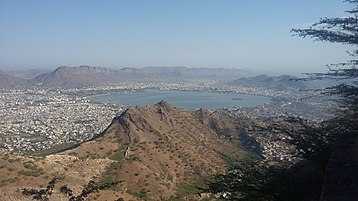 View of Ajmer from Taragarh Fort.
View of Ajmer from Taragarh Fort.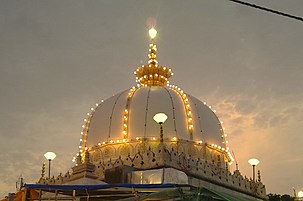 Dargah Sharif Ajmer
Dargah Sharif Ajmer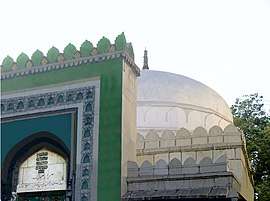 Tomb of Khwaja Husain Ajmeri
Tomb of Khwaja Husain Ajmeri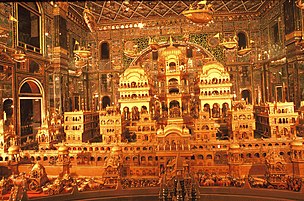 Swarna Nagari in Soniji Ki Nasiyan
Swarna Nagari in Soniji Ki Nasiyan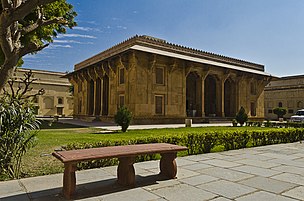 Akbari Fort & Museum
Akbari Fort & Museum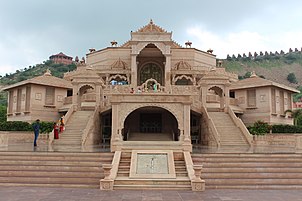 Nareli Jain Temple is a recent addition to Ajmer
Nareli Jain Temple is a recent addition to Ajmer- Baradari on Lake Anasagar
Education
Ajmer is called as the Education City of Rajasthan.[29] The Mayo College and the Government Arts college were the principal educational institutions in the Ajmer - Merwara during the late 19th century. Ajmer is also home to the Rashtriya military school founded in 1930, Sophia Girls' School, Sophia College, St. Anselms, Regional Institite of Education and the Ajmer Music College.
Demographics
| Population growth of Ajmer | |||
|---|---|---|---|
| Census | Population | %± | |
| 1891 | 68,800 | — | |
| 1901 | 73,800 | 7.3% | |
| 1911 | 86,200 | 16.8% | |
| 1921 | 113,200 | 31.3% | |
| 1931 | 119,500 | 5.6% | |
| 1941 | 147,300 | 23.3% | |
| 1951 | 196,300 | 33.3% | |
| 1961 | 231,200 | 17.8% | |
| 1971 | 264,300 | 14.3% | |
| 1981 | 374,400 | 41.7% | |
| 1991 | 402,700 | 7.6% | |
| 2001 | 485,197 | 20.5% | |
| 2011 | 542,321 | 11.8% | |
| source:[30][31][2][30][31][2] | |||
According to the 2011 census, Ajmer had a population of 542,321 in the city, 551,101 including its suburbs.[2]
The female to male ratio in the city was 947/1,000. The literacy rate in the city was 86.52%, male literacy being 92.08% and female literacy being 80.69%.[2]
Ajmer's population growth in the decade was 18.48%; this compares to a growth figure of 20.93% in the previous decade.[31]
| Year | Population |
|---|---|
| 1891 | 68,800 |
| 1901 | 73,800 |
| 1911 | 86,200 |
| 1921 | 113,200 |
| 1931 | 119,500 |
| 1941 | 147,300 |
| 1951 | 196,300 |
| 1961 | 231,200 |
| 1968 | 265,200 |
| 1971 | 264,300 |
| 1981 | 374,400 |
| 1991 | 402,700 |
| 2001 | 485,197 |
| 2011 | 542,321 |
References
- Majumdar, R.C. Volume 5: The Struggle for Empire. Bharatiya Vidya Bhavan. p. 107.
- "Ajmer City Population Census 2011 | Rajasthan". www.census2011.co.in.
- Har Bilas Sarda 1911, pp. 68-74.
- R. B. Singh 1964, p. 87.
- "Hriday Cities | Heritage City Development and Augmentation Yojana (HRIDAY)". www.hridayindia.in. Archived from the original on 28 September 2018. Retrieved 28 September 2018.
- "Introduction". Hriday official website. Archived from the original on 26 August 2015. Retrieved 30 April 2015.
- "Ajmer Tourism: Places to Visit in Ajmer - Rajasthan Tourism". tourism.rajasthan.gov.in. Retrieved 10 March 2017.
- Dasharatha Sharma 1959, p. 40.
- R. B. Singh 1964, p. 88.
- R. B. Singh 1964, pp. 131-132.
- "#World Tourism Day 2018:सूफियत की महक और तीर्थनगरी पुष्कर की सनातन संस्कृति". www.patrika.com (in Hindi). Retrieved 28 September 2018.
- THE IMPERIAL GAZETTEER OF INDIA, 1908. OUP. pp. Extract.
- "Clipping of Patrika Group - Ajmer". Archived from the original on 28 September 2018. Retrieved 28 September 2018.
- Meghani, Zaverchand (April 2011). Gujaratno Jay. Ahmdabad: Gurjar Sahitya Bhavan. p. 62. ISBN 978-81-8461-481-7.
- "Monthly mean maximum and minimum temperature and total rainfall of important cities (PDF)" (PDF). Archived from the original (PDF) on 13 April 2015. Retrieved 28 July 2013.
- "Focus on connecting small cities by air: Manmohan". The Hindu. 21 September 2013. Retrieved 2 October 2013.
- "Kishangarh airport inauguration ends decade long wait of Ajmer residents: CM Raje". Deccan Chronicle. 12 October 2017. Retrieved 13 October 2017.
- "Rajasthan finds favour in railway budget". The Hindu. 26 February 2010. Retrieved 7 June 2014.
- PADMA PURANA - Significance of Pushkara Tirtha
-

- "Muntakhab-ut-Tawarikh - Google Search". www.google.com. Retrieved 21 April 2020.
- "This Temple In Rajasthan Has A Golden Chamber Where 1000kg Of Gold Was Used To Carve Out Depictions Of Ayodhya. It's Truly Mesmerizing!". Daily Bhaskar. 24 July 2017. Retrieved 29 July 2017.
- Mayo College, Ajmere - British Library
- "Akbar Ka Kila, AJMER".
- "Enlightenment completed the pilgrimage area - www.bhaskar.com". dainikbhaskar. 4 April 2016. Retrieved 14 April 2016.
- Gopal, Madan (1990). K.S. Gautam (ed.). India through the ages. Publication Division, Ministry of Information and Broadcasting, Government of India. p. 173.
- The Future of Power - summary report, Ajmer - February 2014
- Prithviraj Memorial Ajmer
- "Ajmer Tourism: Places to Visit in Ajmer, Tour Package - Rajasthan Tourism". www.tourism.rajasthan.gov.in. Retrieved 28 September 2018.
- "Historical Census of India". Archived from the original on 17 February 2013. Retrieved 22 March 2014.
- "Census of India 2001: Data from the 2001 Census, including cities, villages and towns (Provisional)". Census Commission of India. Archived from the original on 16 June 2004. Retrieved 1 November 2008.
Bibliography
- Dasharatha Sharma (1959). Early Chauhān Dynasties. S. Chand / Motilal Banarsidass. ISBN 9780842606189.CS1 maint: ref=harv (link)
- Har Bilas Sarda (1911). "Adhai-Din-ka-Jhonpra" (PDF). Ajmer: Historical and Descriptive. Scottish Mission.CS1 maint: ref=harv (link)
- R. B. Singh (1964). History of the Chāhamānas. N. Kishore. OCLC 11038728.CS1 maint: ref=harv (link)
- W.D. Begg: The Holy Biography of Hazrat Khwaja Muinuddin Chishti (Millat Book Centre, Delhi, 1999).
- Ajmer The Imperial Gazetteer of India, 1909, v. 5, p. 137-146.
External links
- Ajmer District website
- R. Nath Mughal Architecture Image Collection, Images from Ajmer - University of Washington Digital Collection
